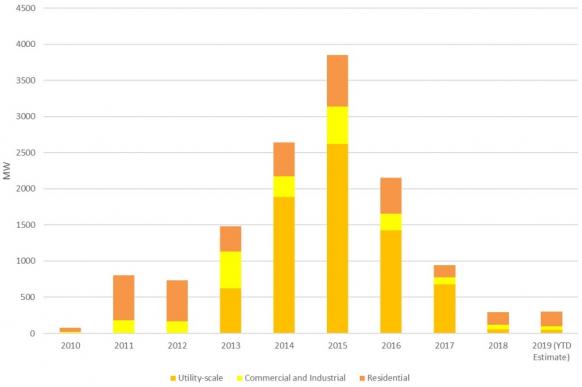Agri-PV builders trial crop, technology in yield-boosting plants
Agri-PV projects can boost farmers' yield and solve land shortage issues but cost reduction will be key to wider deployment, experts told Reuters Events.

Related Articles
Competition over land resources and global climate challenges are driving growing interest in agri-PV, the co-development of land for both solar power and agriculture.
Early movers in agri-PV are developing pilot projects and new technologies that will deepen industry expertise.
GroenLeven, a Dutch subsidiary of solar developer BayWa r.e., is building five pilot agri-PV projects in the Netherlands.
Key challenges for farmers include assessing the impact of the agri-PV project on crop yield and the best crops for the shared environment, Willem de Vries, Project Manager, Large Projects at GroenLeven, told Reuters Events.
GroenLeven will test five different types of crops at the pilot projects that are tolerant to shade: blueberries, red currants, raspberries, strawberries and blackberries.
The projects will use specialised monocrystalline solar panels that offer the plants more light than standard models and more protection from direct sunlight, rain, hail and frost, increasing the crop yield.
The Netherlands has set ambitious carbon reduction objectives and the country holds significant agri-PV potential, de Vries said.
"We have approximately 20,000 hectares of fruit cultivation,” he said. “...if only 50% of that were used in combination with agri-PV, we would be able to realize 8 GW of solar power.” To date, the Netherlands has installed around 7 GW of PV.
UK rebirth
UK farmers have been key supporters of solar power and agri-PV projects could benefit from revamped support measures. In March, the UK government reopened subsidies for solar and onshore wind projects after a four-year moratorium which has favoured less mature technologies like offshore wind.
From next year, PV and onshore wind projects will once again be able to bid for UK contracts for difference (CfDs), the government said. The move will help the UK achieve its target of net zero carbon by 2050, it said.
UK annual solar installations by sector
(Click image to enlarge)
Source: UK Solar Trade Association (STA), November 2019
Around 70% of UK solar capacity is either owned by farmers or hosted on agricultural land, Jonathan Scurlock, Chief Adviser, Renewable Energy and Climate Change, the UK’s National Farmers' Union (NFU), said.
As farmers generally own or lease land under long-term arrangements, they are well positioned to make long-term investments. Many farmers are yet to install solar projects, offering strong growth potential.
"When we survey our members we find over 30% are using solar," Scurlock said.
Higher yield
Agri-PV systems can protect crops against the extreme weather events becoming more frequent due to climate change, Andreas Steinhueser, systems testing lead at Fraunhofer Institute for Solar Energy Systems ISE, said.
“Through active shading and rainwater harvesting techniques, agri-PV offers additional resilience to food supply chains," Steinhueser said. "Take the current heatwave in Europe – in such conditions it's realistic, even in a country such as Germany, for crop yields to actually increase thanks to agri-PV module shading.”
A 194 kW pilot solar field at a 1 hectare agricultural site in Heggelbach, southern Germany, highlighted the complimentary qualities of solar and agriculture.
Based on potato yield, the project increased land-use efficiency by 160% in 2017 and by 186% in 2018, when temperatures were hotter, according to calculations made by Fraunhofer ISE.
Small footprint
In system design, Agri-PV developers must take into account ecological factors as well as farmers' access needs, Steinhueser said.
“The system needs to be designed using materials that will not impact soil fertility (for example, concrete or treated wood), and support pillars need to be spaced so as not to slow down planting and harvesting operations,” he said.
Agri-PV projects could take advantage of rapid advancements in bifacial modules. Agri-PV panels are usually placed one to two meters off the ground, which means bifacial technology can offer efficiency gains, but this will depend on the type of crop, Steinhueser said.
“For example, it’s arguable that bifacial modules wouldn't profit much from diffuse irradiation when used in orchards, so although we think that bifacial modules hold huge promise in agri-PV, the way forward is likely an intelligent mixture of both bifacial and monofacial," he said.
Cost challenge
The gradual phasing out of solar subsidies creates a challenge for agri-PV developers.
Dutch projects can still benefit from incentives of 88 to 99 euros/MWh, depending on the size of the installation, but agri-PV projects do not currently receive any special support beyond that offered to solar farms.
“At this moment, this is a danger for agri-PV installations, as the capex investments are still higher compared with conventional ground-mounted solar installations," de Vries said. The equipment is more specialised and installation methods, such as the driving of piles, can require greater resources.
Longer term, agri-PV costs should fall as supply chains adapt to growing requests for specialised equipment, de Vries noted.
Growth-hungry developers must establish business models that can be repeated in different markets.
While the Heggelbach plant was small in scale and received research funding, it demonstrated the application of community-based financing.
This type of business model, incorporating funding from local cooperatives, authorities or businesses, could be one solution to overcoming the barrier of high upfront costs, Steinhueser said.
Reporting by Ed Pearcey
Editing by Robin Sayles

